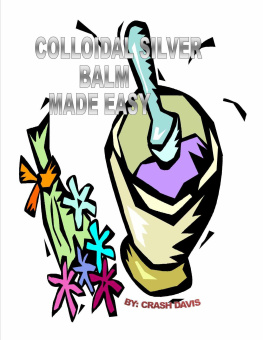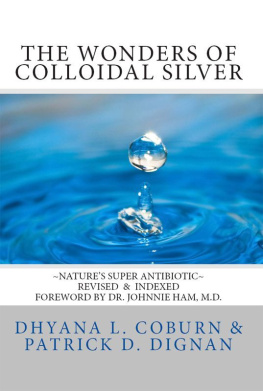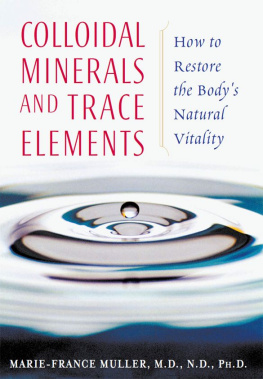Colloidal Silver
For
$.99 Per Gallon
by
J. D. Sandlin
Disclaimer
This book is written for information only. It has not been written to encourage anyone to prescribe or practice medicine. All of the information provided is based upon my own research and personal experience. Anything that I have experienced will not necessarily apply to anyone else.
All attempts possible have been made to verify the information provided. The author assumes no responsibility for errors, omissions or contrary interpretations of the information discussed.
This book is for entertainment only. The information expressed is that of the author only and should not be taken as expert instruction. The reader is responsible for his or her own actions taken in response to information in this book.
The author takes no responsibility or liability on behalf of the reader of this book.
Any perceived slight of any individual or organization is unintentional.
Table Of Contents
What Is Magic Water?
History Of Silver In Medicine
What Is Colloidal Silver Reported To Do?
My Personal Adventure With Magic Water
Government Attitude Toward Silver Medicine
Toxicity-Is Colloidal Silver Safe?
Claims From Users
How To Make A Colloidal Silver Generator
Summary
What Is Magic Water?
Magic water is the name given by me and my family for colloidal silver. Colloidal silver is a fluid containing minute silver particles ( as small as 1/10,000 inch ) held in suspension in water.
The colloidal silver that will be described is made through the process of electrolysis. The solution contains charged silver particles so small they cannot be seen with the naked eye.
Electrolysis is the chemical action which is connected with the passage of electricity through an electrolyte. In our case, electricity is passed from one silver source to another through a medium of water. Many of the ions of silver and minute particles will remain in the water when the process is ended.
Because of the small size and positive electrical charge, the particles repel each other in the solution and thus stay suspended in the water indefinitely and do not settle out.
The process of making colloidal silver varies with each individual described. Every maker claims to know the only process, the only ingredients and the only true results.
This book is based upon my own research and experience. My research agrees with some reports and totally disagrees with others. If you choose to believe information other than what is contained in this book, go with that.
How does colloidal silver work? Some have described it as a catalyst that disables a particular enzyme in a disease causing cell, as it transfers oxygen and nutrients. The disease organism suffocates. The colloidal silver will cripple the activity of the particular enzyme common to all viruses, fungus and bacteria, while at the same time not affecting the enzymes of live tissues.
History Of Silver In Medicine
The use of silver for medicinal purposes is nothing new. Our great grandparents placed a silver dollar in milk to keep it from spoiling. The Phoenicians are said to have stored water, wine and vinegar in silver containers to prevent spoiling. The ancient Greeks recognized that families eating from silver utensils rarely were sick or had few infections . As time went on, rulers and the wealthy adopted the practice of using silver plates , silver cups and silver utensils to avoid infectious illness.
Hippocrates, the father of medicine, wrote that silver had beneficial healing and anti-disease properties.
Prior to World War II, silver was known as a powerful antibiotic and anti-fungal substance and was prescribed for a great variety of diseases and infections. None of today's antibiotics were available so colloidal silver was used extensively. It consisted of ground up silver suspended in a liquid. These products were very expensive and were available to mainly the wealthy. Physicians used colloidal silver as an eye drop for ophthalmic problems. Sometimes it was taken internally for diseases such as epilepsy, gonorrhea and the common cold.
With the introduction of antibiotics in the 1940's, the use of silver as an antimicrobial agent diminished.
In 1938, the pharmaceutical industry made a startling discovery. The discovery was not a kind of medicine. It was:
People will pay for drugs.
What Is Colloidal Silver Reported To Do?
I have in my possession a copy of a letter issued by the University of North Texas, Department of Biological Sciences on April 24, 2000. The letter reports on tests of a particular brand of colloidal silver against five common bacterial pathogens ( staphylococcus epidermidis, staphylococcus aureus, enterococcus faecalis and salmonella typhimurium ) and one fungal pathagen ( candida albicans ).
The bacterial pathogens, when exposed to colloidal silver, were reduced from 10 billion germs to an undetectable level in less than four minutes.
One billion candida pathogens were reduced to undetectable levels in less than two minutes when exposed.
It has been reported that having silver in the bloodstream increases the healing process of fractured bones.
The following is a partial list from pre-1938 documented uses of silver, specifically in colloidal form, for the treatment of various conditions and pathogens.
Acne, arthritis, athlete's foot, bladder inflammation, burns, B. tuberculosis, cancer, colitis, cystitis, diphtheria, diabetes, dysentery, ear infections, Eustachian tubes, eczema, fibrosis, gonorrheal herpes, gonorrhea, impetigo, influenza, intestinal conditions, leprosy, leukemia, lupus, malaria, meningitis, neurasthenia, ophthalmology, canine parvo virus, pneumonia, pleurisy, prostate, rheumatism, ring worm, rhinitis, seborrhea, septic ulcers, sepsis, septicemia, skin cancer, shingles, soft sores, spruce, staph infections, tuberculosis, tonsillitis, toxemia, typhoid, trench foot, ulcers, warts, whooping cough and yeast infections.
Wikipedia states The silver ion ( Ag+ ) is bioactive and in sufficient concentration readily kills bacteria in vitro. Silver also kills bacteria in external wounds in living tissue, so physicians use wound dressings containing silver sulfaiazine ( Ag-SD ) or silver nanomaterials to treat external infections. Wound dressings containing silver are increasing in importance due to the recent increase of antibiotic-resistant bacteria, such as MRSA. The disinfectant properties of silver are used in medical applications, such as urinary catheters and endotracheal breathing tubes, where silver content is effective in reducing incidences of catheter-related urinary tract infections and ventilator-associated pneumonia ( VAP ), respectively. Silver is also used in bones prostheses, reconstructive orthopedic surgery and cardiac devices, as well as on surfaces and fabrics to reduce the spread of infection. Liquid sprays containing nano-silver are effective as a hard-surface disinfectant.
Perhaps you have noticed band-aid type products in the grocery store. Curad has a product with a silver impregnated pad.
Drinking water supplies of Russian Mir orbital station and the International Space Station have used electrolytically dissolved silver as a disinfecting agent.
The World health Organization uses colloidal silver to provide safe drinking water in developing nations.
In World War I, before the introduction of antibiotics, silver compounds were used to prevent and treat eye infections. Silver nitrate can be used as eye drops to prevent conjunctivitis in newborn babies. The standard in topical burn treatment is silver sulfadiazine ( AgSD ). Silver is impregnated in to the burn dressing as a useful antibacterial agent for burn treatment.
A study administered by Hull york Medical School found that an antimicrobial barrier dressing containing silver provided a highly effective barrier to the spread of MRSA into the wider hospital.
Next page









